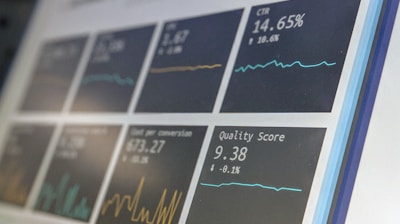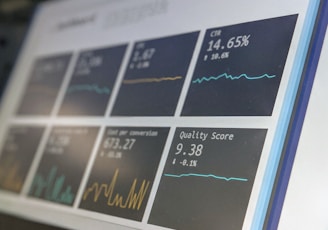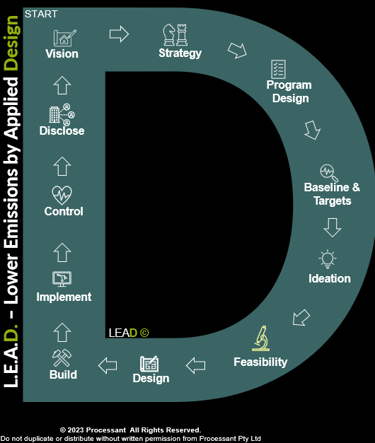
The homes of 200 million people will be below sea level in 70 years ...
Foundation, Design and Change are the key pillars of L.E.A.D.
Pillar 1: Foundation
Strong foundations are crucial for long-term success. In order to achieve this, it is important to establish a clear vision and strategy and understand your obligations. This stage also involves ensuring that the program structure is well-designed and efficient. Additionally, setting meaningful goals and targets is essential. These goals and targets should be aligned with the overall vision and strategy and serve as a roadmap for success. By laying down strong foundations, organisations can create a solid framework upon which to build and grow.
Vision & Strategy
Program Design
Baseline & Targets






Pillar 2: Design
The process starts with collaborating with stakeholders and experts to gather different perspectives and generate innovative ideas. Reviewing industry best practices allows us to stay informed about the latest trends and approaches. Thinking outside the box helps us to come up with unconventional solutions that can potentially bring significant benefits. Conducting a prioritisation and feasibility analysis is essential in order to determine which ideas are most viable and align with your goals. This analysis helps us to make informed decisions and prioritise the development of solutions that are practical and achievable. By following this process, we can build a solution that not only meets your goals but also addresses the needs and requirements of all stakeholders.
Build
Ideation & Feasibility
Applied Design






We actively engage your teams to brainstorm ideas that directly pertain to Scope 1, Scope 2, and Scope 3 emissions. By involving your teams, we tap into their diverse perspectives and expertise to generate a wide range of innovative ideas. These ideas form the foundation for our subsequent steps. We then thoroughly assess the feasibility of each idea, conducting a factual analysis to ensure its viability. To ensure that our analysis is comprehensive and aligned with industry standards, we overlay the ideas with industry best practices. This approach allows us to identify the most feasible ideas that have the potential to significantly reduce your emissions. By involving your teams and considering industry best practices, we ensure that the ideas we develop are not only creative but also practical and achievable.
To convert an idea into a practical design document that caters to all stakeholders, a systematic approach is crucial. This phase involves consultations with various stakeholders to gather their inputs and ensure their needs are considered. After gathering all necessary information, the design document or wireframes are created, outlining the project's scope, timelines, and deliverables. This document acts as a blueprint, guiding the implementation process and ensuring that the final product meets the expectations of all stakeholders. Clear communication throughout the process is vital to ensure transparency and alignment among the team. By following this approach, ideas can be transformed into practical designs that benefit all parties involved.
We collaborate closely with your developers to effectively manage and oversee the implementation of technology solutions that align with the needs of stakeholders. As product owners and agile leads, we take charge of ensuring that the teams work in an efficient and productive manner. We are committed to addressing any queries or concerns promptly, enabling a smooth and seamless development process. Our aim is to ensure that the final product meets all stakeholder requirements and delivers optimal results. With our expertise in project management and deep understanding of technology, we are dedicated to facilitating a successful outcome.
Pillar 3: Change
Once a design is implemented, it is crucial to continuously review and monitor its performance. This ensures that the desired outcomes are achieved and any necessary adjustments can be made. It is important to report the outcomes accurately and consistently, following the regulatory requirements. Stakeholders, including both internal and external parties, should be informed and educated whenever necessary. By keeping all stakeholders well-informed, they can understand the progress and impact of the implemented design, making it easier to align their expectations and provide relevant feedback. This ongoing review, monitoring, reporting, and communication process ensures that the design remains effective and meets the needs of all stakeholders.






Once the design takes form, we ensure that it integrates well within the organisation. This includes preparing for the go-live phase by ensuring readiness and communicating effectively with the various areas that will be impacted, allowing for a seamless transition and optimal functionality.
During the control stage, measures are implemented to ensure that the planned process operates seamlessly. This involves profiling of data, monitoring data quality and addressing any issues that arise. We ensure that controls are automated and proactive where possible.
During the disclose stage, it is essential to provide the necessary reports to both management and regulators. These reports serve to inform them about the progress made in a transparent and accountable manner. Additionally, communication plays a crucial role in this stage as it ensures that the entire organisation is aware of the progress being made. This fosters a sense of unity and shared responsibility.
Implement
Control
Disclose



